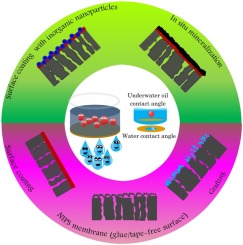Progress in Polymer Science ( IF 27.1 ) Pub Date : 2019-10-04 , DOI: 10.1016/j.progpolymsci.2019.101166 Soheil Zarghami , Toraj Mohammadi , Mohtada Sadrzadeh , Bart Van der Bruggen

|
Wastewaters containing oil-in-water (O/W) emulsions are generated daily in various industrial processes such as petroleum refining, petrochemical and metal finishing. Environmental and economic concerns related to the disposal of oily wastewaters emphasize demands for materials and methods that can effectively separate oil from water. Pressure-driven membrane processes have been employed for oil/water separations. The major challenge that hinders the suitability of membrane technology for industrial oily wastewater treatment is the adsorption of oil and surfactants onto the membrane surface and/or within the pores of the membrane, which severely deteriorates the membrane performance. Materials with both hydrophobic and oleophilic properties have attracted significant attention in recent years for oil removal from water. These oil-removing type of materials can be used for membrane filtration or selective and efficient absorption of oil from water. The application of oil-removing materials can successfully introduce special wettability to the oily wastewater treatment. However, these materials are fouled quickly by oil droplets because of their intrinsic oleophilic properties. The attached oil droplets on the membrane surface severely affect separation efficiency. Besides, the adhered oil droplets are hardly removable from the surface resulting in reduced life-cycle of oleophilic materials, and this thus necessitates the need for costly post-treatment processes. Therefore, it is essential to develop high-performance materials for oil/water separation with elevated separation efficiency and significant antifouling properties. This study aims to review the state-of-the-art superhydrophilic and underwater superoleophobic (SUS) membranes that are being developed to overcome the aforementioned challenges. This allows to probe the maximal potential of developing such materials, and to explore the feasibility of using these novel membranes for de-oiling processes conventionally performed using expensive and low-performance skim tanks and adsorbents. In this review, according to the various materials that have been used for membrane fabrication, development methods for membrane synthesis with SUS properties based on polymeric SUS membranes and organic-inorganic hybrid SUS membranes including grafting, non-solvent phase separation (NIPS) polymeric membrane with hierarchical glue/tape-free surface, surface coating, in situ mineralization combined with polymeric materials and surface coating of polymeric membranes with inorganic nanoparticles, respectively, are assessed, in view of suggesting the success potential of these methods.
中文翻译:

超亲水和水下超疏油膜-合成方法综述
每天在各种工业过程(例如石油精炼,石化和金属精加工)中都会产生包含水包油(O / W)乳液的废水。与含油废水的处理有关的环境和经济问题强调了对可有效将油与水分离的材料和方法的需求。压力驱动的膜工艺已用于油/水分离。阻碍膜技术适用于工业含油废水处理的主要挑战是油和表面活性剂在膜表面和/或膜孔内的吸附,这会严重降低膜的性能。近年来,具有疏水性和亲油性的材料引起了人们对于从水中去除油的关注。这些除油类型的材料可用于膜过滤或从水中选择性和有效地吸收油。除油材料的应用可以为含油废水的处理成功地引入特殊的润湿性。但是,这些材料因其固有的亲油性而很快被油滴污染。膜表面附着的油滴严重影响分离效率。此外,粘附的油滴几乎不能从表面除去,导致亲油性材料的寿命缩短,因此需要昂贵的后处理工艺。因此,重要的是开发具有提高的分离效率和显着的防污性能的用于油/水分离的高性能材料。这项研究旨在回顾为克服上述挑战而开发的最新超亲水和水下超疏油(SUS)膜。这可以探究开发这种材料的最大潜力,并探索使用这些新型膜进行常规除油过程的可行性,这些过程通常是使用昂贵且性能低下的脱脂槽和吸附剂进行的。在这篇综述中,根据用于膜制造的各种材料,开发了基于SUS聚合物和具有有机,无机杂化SUS膜(包括接枝,非溶剂相分离(NIPS)聚合物膜)的具有SUS特性的膜合成的开发方法具有分层的胶水/无胶带表面,表面涂层,这可以探究开发这种材料的最大潜力,并探索使用这些新型膜进行常规除油过程的可行性,这些过程通常是使用昂贵且性能低下的脱脂槽和吸附剂进行的。在这篇综述中,根据用于膜制造的各种材料,开发了基于聚合物SUS膜和有机-无机杂化SUS膜(包括接枝,非溶剂相分离(NIPS)聚合物膜)的具有SUS特性的膜合成的开发方法具有分层的胶水/无胶带表面,表面涂层,这可以探究开发这种材料的最大潜力,并探索使用这些新型膜进行常规除油过程的可行性,这些过程通常是使用昂贵且性能低下的脱脂槽和吸附剂进行的。在这篇综述中,根据用于膜制造的各种材料,开发了基于聚合物SUS膜和有机-无机杂化SUS膜(包括接枝,非溶剂相分离(NIPS)聚合物膜)的具有SUS特性的膜合成的开发方法具有分层的胶水/无胶带表面,表面涂层,考虑到这些方法的成功潜力,分别评估了与聚合物材料结合的原位矿化和分别用无机纳米粒子对聚合物膜进行表面涂层的方法。



























 京公网安备 11010802027423号
京公网安备 11010802027423号